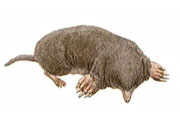

It can also help us to better protect moles from these predators and ensure their continued survival in the wild. Understanding the natural predators of moles and their hunting strategies can help us to appreciate the incredible adaptations and strategies that exist within the natural world. They will use their sharp teeth and claws to catch their prey and quickly dispatch them. Other predators, like weasels and stoats, are particularly agile and can maneuver through the narrow tunnels of a mole’s burrow system. Once they have located their prey, they will swoop down and catch it with their talons. Some predators, such as birds of prey, have particularly sharp vision and are able to spot moles from a great distance. Ambush predators, on the other hand, will wait patiently near a mole tunnel entrance and attack when the mole emerges. Active hunters, like foxes, will actively search for their prey and chase them down. In terms of hunting strategies, predators of moles tend to be either active hunters or ambush predators. These animals are able to catch moles either by digging into their tunnels or by ambushing them as they surface.

Other natural predators of moles include birds of prey, such as owls and hawks, and small carnivorous mammals like weasels and stoats. Once they have located their prey, they will dig down into the tunnel and use their sharp teeth to catch the mole.

These clever canines have keen senses of smell and are able to track moles through their tunnels. One of the most common predators of moles is the red fox. These predators have evolved a number of different hunting strategies to catch their small, elusive prey. The reality is that moles are preyed upon by a variety of natural predators.

Understanding their importance can help us to appreciate the complexity and interdependence of the natural world, and inspire us to take steps to protect and preserve it. In short, moles are an integral part of their ecosystem, playing a vital role in soil structure, plant growth, and the survival of other animals. By providing food for these predators, moles help to maintain a healthy balance within their ecosystem and ensure the survival of other species. In return, the tunnels created by moles provide these plants with access to oxygen and carbon dioxide, which they need for photosynthesis.įurthermore, moles are an important food source for many predators in their ecosystem. These roots can absorb water and nutrients that would otherwise be unavailable, which helps the plants to thrive. Some plants, such as clover and alfalfa, have deep roots that can reach the tunnels created by moles. Moles also have a symbiotic relationship with certain plant species. These animals, in turn, help to further improve the soil structure and promote plant growth. For example, the soil that moles help to create provides a habitat for a variety of other animals, from insects to earthworms. Moles also help to control pests by eating insects that can damage plant roots and reduce crop yields.īut moles do not exist in isolation – they are part of a complex web of interactions within their ecosystem. This, in turn, promotes plant growth and enhances soil fertility. Their tunnels help to aerate the soil, which improves its structure and allows water and nutrients to penetrate more deeply. Their burrowing activities help to create complex underground tunnels that have a variety of benefits for the soil and other animals in their habitat.įirst and foremost, moles are soil engineers. Moles may be small and unassuming, but they play a crucial role in their ecosystem. What can be done to protect moles from predators? Importance of Moles in Their Ecosystem In addition, knowing more about the hunting strategies of these predators can also give us insights into the complex web of interactions that exist within ecosystems. By understanding which predators prey on moles, we can better protect these small mammals and ensure their continued survival in the wild. This is where the importance of studying what animals eat moles comes in. However, despite their many benefits, moles also have a number of natural predators that pose a threat to their survival. Their burrowing activities help to aerate soil and improve its structure, which in turn promotes plant growth and soil fertility. These little mammals are known for their unique physical characteristics, including their tiny eyes, strong forelimbs, and sharp claws, which make them expert diggers.īut moles are not just interesting to observe – they also play an important role in their ecosystem. Moles, those small, furry creatures that burrow underground, are fascinating animals that have captured our attention for years.


 0 kommentar(er)
0 kommentar(er)
